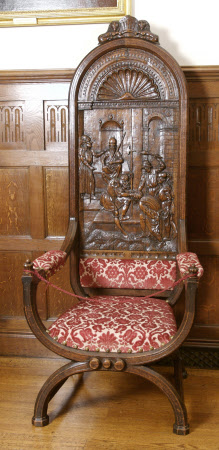Armchair
Category
Furniture
Date
circa 1600 (the back panel) - circa 1830 (the seat)
Materials
Oak
Measurements
186 x 73 x 66 cm
Order this imageCollection
Dunster Castle, Somerset
NT 725631.1
Summary
One of a pair of carved oak high-back throne-like open armchairs, the panels probably Flemish and circa 1600, the frame-work and seats circa 1830. The panels carved in detail and depicting scenes from The Passion of Christ, one showing the arrest of Christ, the other the flagellation of Christ, each top section carved with a large shell within a dentil-moulded arch and surmounted with a crest of a crown flanked by lions, the lower portion of the back together with the arms and the seat all upholstered, the arms with curved front supports and finials, the frames incised and chamfered, standing on arched square legs with block feet and cross-stretchers. This pair of chairs can be seen in a photograph of the Outer Hall taken in the 1880s, although nothing is known about their provenance.
Full description
Four chairs of identical form, but with different carved scenes in the back panels, can be seen in Winchester Cathedral. Little is known of their history apart from the fact that they were gifted to the Cathedral in 1960. During the 1820s and 1830s there was a huge movement of church furniture, woodwork and furnishings into England from France and particularly Flanders. Its availablity fed the Gothic revival in England and the ideal of creating the Romantic interior in country houses. It was also the era of the re-establishment of the Catholic church in England and some of this furniture found its way into private chapels, new churches and training colleges. In the main, the supply came through London dealers and auctions. It is probably in this context that the Dunster and Winchester Cathedral chairs were made, possibly originally part of a large set of chairs created from the set of panels. See Charles Tracy Continental Church Furniture in England - A Traffic in Piety, ACC 2001 for a full study on this topic.
Provenance
Previously on loan from Lt.Col. Geoffrey Walter Fownes Luttrell 1975. Gifted 24/6/1981. This pair of chairs can be seen in the photograph of the Outer Hall taken in the 1880s, although nothing is known of their earlier provenance.
